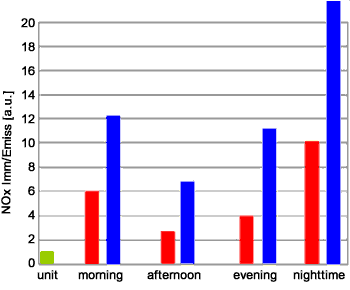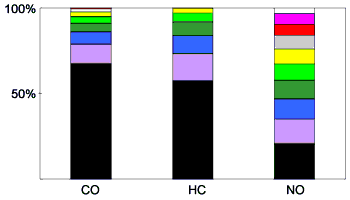|
Global mobility has increased enormously since the
second half of the past century. Surface and air transport provide
seemingly limitless services for both passengers and merchandise. The
downside of this mobility is the increased emission of air toxics which
impact on ambient air quality.
Our studies in the LUBETRAX projects (see below) and other alpine transit
projects have shown that the average air pollution in alpine valleys that
is caused by a road vehicle is (i) three times as
high as it would be in a flat plain, (ii) is more than twice as high in
winter than in summer (iii) is six times higher during nighttime than
during daytime. This means that the ambient air pollution caused by a road
vehicle on a winter's night in an alpine valley is about 50 times higher
than it would be on a summer's day in a flat region.
|
The relative increase in impact of a vehicle on the transit route
through the Alps in summer (red) and in winter (blue)
during morning, afternoon, evening and nighttime (50-fold in the
winter).
The units are based on the pollution dispersion on flat terrain
during the daytime in the summer (green bar).
|
|

|
In the LUBETRAX project we collaborated with the University of Denver in
determining the emissions of heavy road vehicles on the alpine freeway A2
going over the Gotthard pass. The Remote Sensing technology (RSD) allowed
us to determine the emission components as the vehicle was passing by
(on-road). The detailed analysis of 2'000 vehicle emissions showed that the
dirtiest 10% accounted for about half of all CO and HC emissions, but only
for 19% of total NO-emissions.
|
Percentages of CO-, HC-, und NO-emissions of heavy road vehicles
:the 10% worst of all vehicles accounted
for 68% of all CO-emissions, 57% of all HC-emissions and 19% of
all NO-emissions (black bar)
|
|

|
|